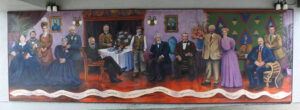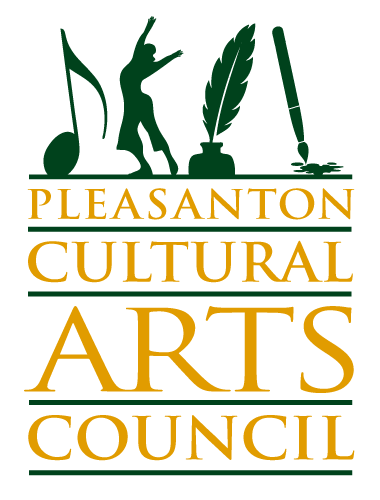Pioneer Founders Mural
 Phoebe Hearst, (standing far left) philanthropist and mother of William Randolph Hearst, opens her home parlor to the founders of Pleasanton on the six-paneled mural at 608 Main Street, Pleasanton. The mural, installed in 2014, celebrates the pioneers who had a notable impact in the valley. On the wall of Phoebe’s parlor, a framed picture of Civil War Union general Alfred Pleasonton reveals John Kottinger’s intention. Kottinger intended to name the town after the General, but a clerical error misspelled his name, and it was recorded as Pleasanton.
Phoebe Hearst, (standing far left) philanthropist and mother of William Randolph Hearst, opens her home parlor to the founders of Pleasanton on the six-paneled mural at 608 Main Street, Pleasanton. The mural, installed in 2014, celebrates the pioneers who had a notable impact in the valley. On the wall of Phoebe’s parlor, a framed picture of Civil War Union general Alfred Pleasonton reveals John Kottinger’s intention. Kottinger intended to name the town after the General, but a clerical error misspelled his name, and it was recorded as Pleasanton.
Master artist, Barbara Stanton, and a cadre of volunteer artists undertook the daunting task of bringing to life the portraits of sixteen founders. Stanton came to this task as an acclaimed miniature portrait artist which raised some doubts about her ability to handle the expanse of six 4’ x 8’ acrylic framed panels. She did not shy away from the task, and with the help of research by Gary and Nancy Harrington, local historian Charles Huff, the Museum on Main, and personal archive photos, the faces of the past emerge to reveal stories.
 From left to right the founders are identified by the ribbon scroll below the images: Joshua and Angela Neal, Phoebe Hearst, John and Marie Kottinger, Henry Mohr, Joseph Black, Jose Guzman “Old Indian Joe”, Jose Amador, Agostin Bernal, Walter Briggs, Edith Ziegenfuss, Tom Orloff, and Cornelius Nevin. The other wall painting is of Chief Tarino. Although these notables each contribute a story of Pleasanton’s past, the artist brings forth subtle references with careful examination.
From left to right the founders are identified by the ribbon scroll below the images: Joshua and Angela Neal, Phoebe Hearst, John and Marie Kottinger, Henry Mohr, Joseph Black, Jose Guzman “Old Indian Joe”, Jose Amador, Agostin Bernal, Walter Briggs, Edith Ziegenfuss, Tom Orloff, and Cornelius Nevin. The other wall painting is of Chief Tarino. Although these notables each contribute a story of Pleasanton’s past, the artist brings forth subtle references with careful examination.
Notice the names on the scrolling ribbon. The image to the far left is obviously a seated woman, yet the scroll reads Joshua Ayers Neal then Angela Bernal Neal. Why? In the early 1800’s once a woman was married, her legal existence was extinguished. Regarding property, a woman’s husband or another male relative controlled any property allocated to her. She could not make a contract. In the case of Joshua Neal, Angela’s dowry brought 530 acres to the marriage and under the control of her husband. The same could be said of the dowry of Marie Bernal brought to the control of John Kottinger. Notice again, the husband’s name is listed first as was the custom.
In 1848 the landmark New York State Married Property Act enacted laws granting specific property rights to women. It was the beginning of proposed changes across the United States. By 1900, every state had given married women substantial control over their property. But women faced gender bias when it came to financial matters. It would take until the 1970s before a woman was able to obtain a credit card in her own name. Before then, a woman still needed her husband’s signature.
Roses of different colors and hues grace the mural. Fourteen figures command attention in the mural. In the hand or pinned-on attire is a rose. Suffragette Edit Ziegenfuss wears her rose in her hair. Pleasanton claimed to be the rose capital of the world, yet the Jackson & Perkins business first started in Newark, New York in 1872 with a wholesale farm devoted to producing a few varieties of fruit and produce. By 1939 Jackson & Perkins were hybridizing roses and entered the New York World’s Fair showcasing 8,000 roses. Eventually, the business opened a western growing location in the fields of Pleasanton and had a shop on Main Street. Perkins claimed to be the “The World’s Largest Rose Grower” leading to Pleasanton adopting the red Don Juan Rose as the City’s flower. Eventually, Perkins left for farming in the San Joaquin Valley, but the love of roses stayed in Pleasanton.
There were seven other rose growers leasing land in the Pleasanton area and 12 million rose plants growing in the valley. By 1990, the last rose company left Pleasanton. Interestingly enough, Rose Street is not named for the rose business but probably J.A. Rose, a business and landowner who married Josephine Bernal, daughter of Augustine Bernal in 1874.
Notable persons in the artwork have lent their names to Pleasanton’s streets, schools, and parks. Hearst Elementary is named for Phoebe Hearst, Mohr Elementary reflects Henry Mohr, Bernal Ave and Park drew its name from the Bernal family, Tom Orloff lends his name to Orloff Park as does other naming reminders around Pleasanton.
Phoebe’s parlor displays her passion for discovery and education. As the wife of wealthy George Hearst, she was afforded considerable funds to travel and acquire items. As a widow, she retained control over his estate. The blue Chinese vase, sophisticated patterned wallpaper, intricately fashioned furniture, collection of Native American baskets (top of the mural and on the table) and an indigenous wall rug attest to her expansive cultural taste later leading to the founding of the Phoebe Hearst Museum of Anthropology, Berkeley, CA.
Some great masters have included their images in their paintings. Raphael’s School of Athens includes the artist’s self-portrait between Ptolemy and Zoroaster. In the case of this mural, the tabletop bears a framed miniature portrait of the artist, Barbara Stanton. One has to wonder if the artist is distantly related to Elizabeth Cady Stanton, suffragette and contemporary of Phoebe Hearst. Certainly, it is known Barbara attended Pleasanton Elementary schools, graduating from Foothill High School. She later attended Las Positas College and completed one semester at the Academy of Arts in San Francisco. She now teaches art and is an active artist, residing in Livermore, California.
The Harrington Art Partnership and the 2013 Pleasanton Leadership class funded the Pioneer Mural with the intent of honoring those who shaped the town of Pleasanton. “Indian Joe” Guzman (standing) and the wall picture of Chief Tarino remind us of the original inhabitants of the valley. The setting of Phoebe Hearst’s parlor gives us a glimpse into a past with undercurrents of social issues and events that shaped lives. Two pairs of exterior vintage sconces flank the mural and cast light when the sun goes down. They serve to illuminate the message from the artist and her volunteers……remember.
Jan Coleman-Knight
